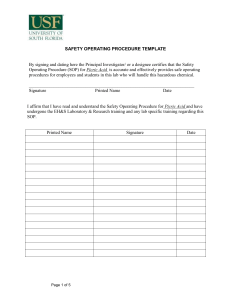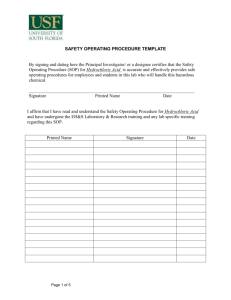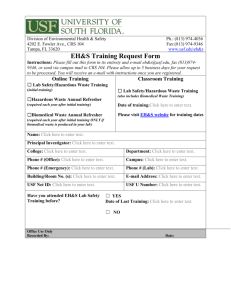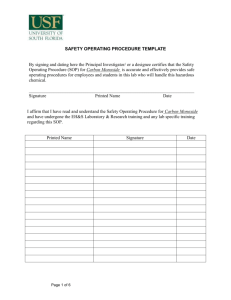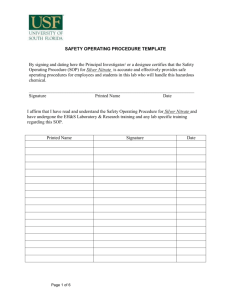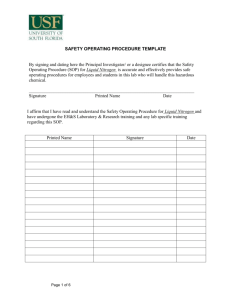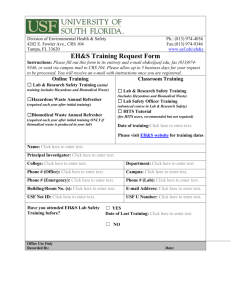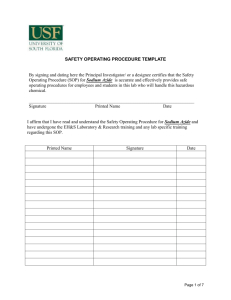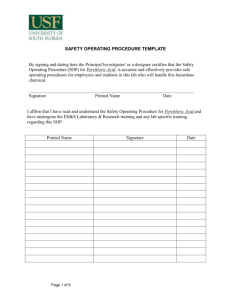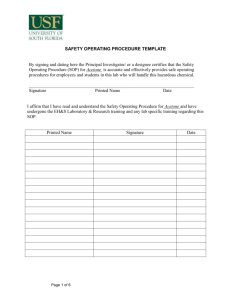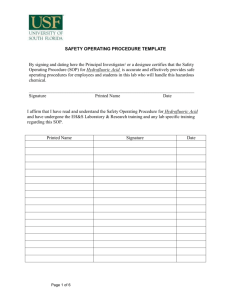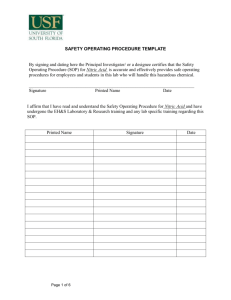Diethyl Azodicarboxylate (DEAD)
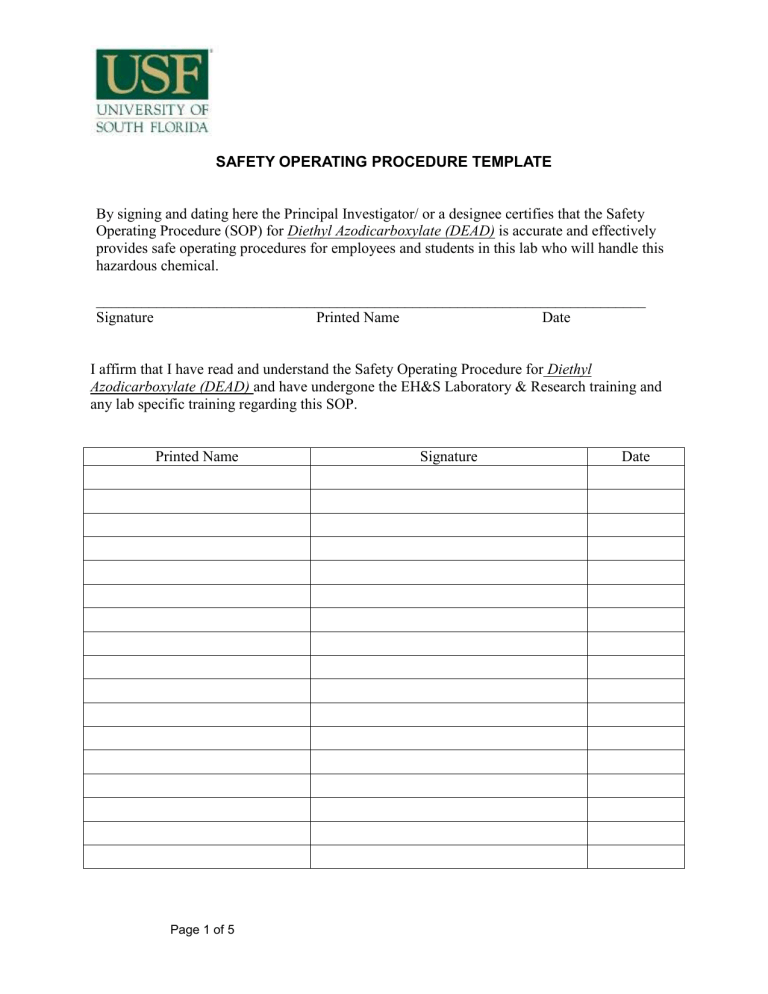
SAFETY OPERATING PROCEDURE TEMPLATE
By signing and dating here the Principal Investigator/ or a designee certifies that the Safety
Operating Procedure (SOP) for Diethyl Azodicarboxylate (DEAD) is accurate and effectively provides safe operating procedures for employees and students in this lab who will handle this hazardous chemical.
_________________________________________________________________________
Signature Printed Name Date
I affirm that I have read and understand the Safety Operating Procedure for Diethyl
Azodicarboxylate (DEAD) and have undergone the EH&S Laboratory & Research training and any lab specific training regarding this SOP.
Printed Name Signature Date
Page 1 of 5
CONTACT INFORMATION:
Chemical Name:
Building/Room
Number:
Date of
Creation/Revision
Principal Investigator:
Emergency Phone number:
Diethyl Azodicarboxylate (DEAD)
10/30/2014
(The PI, Lab Supervisor, or Autonomous Researcher)
HAZARD SUMMARY
List all physical and health hazards associated with the chemical in this SOP. Examples of potential hazards include: toxicity, reactivity, flammability, corrosivity, pressure, etc.
Potential physical and health hazards associated with the use of this chemical include: Diethyl azodicarboxylate (DEAD) is an organic compound that may be harmful if ingested, inhaled, or absorbed through the skin. It causes irritation to the gastrointestinal tract, respiratory tract, skin, and eyes.
Heating the chemical may cause an explosion. DEAD is normally purchased as a diluted solution in toluene due to its explosive potential. DEAD has several applications including its use in pharmaceuticals and in different chemical reactions. It is an efficient dehydrogenating agent and is an important reagent in the Mitsunobu reaction. It also has important uses in the Michael reaction and
Diels-Alder reaction.
SPECIAL HANDLING AND STORAGE REQUIREMENTS
Describe special handling and storage requirements for this hazardous chemical in your laboratory, i.e. restricted access to chemical, inclusion of designated areas to limit and minimize possible sources of exposure to these materials.
The entire laboratory, a portion of the laboratory, or a laboratory fume hood or bench may be considered a designated area.
Special handling and storage requirements for this chemical include:
Precautions for safe handling: Avoid contact with skin, eyes, and clothing. Avoid inhalation and ingestion.
Provide adequate ventilation. Keep away from heat and other sources of ignition- No smoking. Prevent build-up of electrostatic charge.
Conditions for safe storage: Keep container tightly closed in a cool, dry, and well-ventilated area. Opened containers must be carefully resealed and kept upright to prevent leakage. Protect from heat. Avoid strong
Page 2 of 5
oxidizing agents, strong bases, strong acids, and strong reducing agents.
Extra Precautions: based on the instability of this chemical under certain conditions, further approval to use may be indicated by the PI. See the Prior Approvals section for more information.
ENGINEERING AND VENTILATION CONTROLS
Include requirements for specific engineering/ventilation controls for this specific chemical, i.e. fume hood . If the process does not permit the handling of such materials in a fume hood, the lab personnel should contact
Environmental Health and Safety at x4-4036 for review the adequacy of ventilation measures.
Components with workplace control parameters:
Toluene (CAS 108-88-3) Should be kept on hand incase this chemical becomes unstable. Situations to cause this chemical to become unstable include temperature changes. Control Parameters for toluene:100ppm/375mg
Handling processes should be designed to minimize the potential for splash, splatter, or other likely scenarios for accidental contact.
The handling of this chemical must be conducted in a fume hood.
Additional engineering/ventilation controls for the handling of this chemical include:
Chemical fume hood. Adequate exhaust and capture filtration. Electrically grounded lines and equipment.
PERSONAL PROTECTIVE EQUIPMENT
Include specific personal protective equipment required for the handling of this chemical. See the following references:
1. The USF Hazardous Inventory Tracking System (HITS) provides access to MSDS.
2. A glove compatibility chart provides specific information on the type of safety gloves that should be used
based on the hazards of specific chemicals.
3. The following EH&S webpage provides links to glove manufacturers as well as other PPE selection resources, http://www.usf.edu/administrative-services/environmental-health-safety/laboratorysafety/chemicals.aspx
.
At minimum, safety glasses, lab coat, and gloves are to be worn when using this hazardous chemical.
Additional PPE Requirements for the handling of this chemical include:
appropriate clothing (long pants, close-toed shoes)
gloves; indicate type: Nitrile
safety goggles
face shield: recommended
flame-resistant lab coats: Made of anti-static material
□ other :__________________________
If the use of an N95, half mask, or full face respirator is requested, the individual and/or their supervisor must first contact Environmental Health & Safety for a consultation to determine if respirator
Page 3 of 5
use is necessary. If EH&S determines the use of a respirator is necessary, the individual must participate in the University’s respirator program. This includes a medical evaluation; respirator fit test, and training.
EMERGENCY PROCEDURES
If a there is a spill involving an extremely hazardous chemical, emergency responders should be contacted immediately. Dial 911 during and after normal business hours to contact the local emergency responders for your area and provide detail information to the emergency responders including chemical name, volume, hazards, spill location, and any injuries incurred. Building occupants can be notified of a building evacuation through the activation of a fire alarm pull station.
Personnel: If lab personnel are exposed to an extremely hazardous chemical, call 911 immediately. Remove any contaminated clothing, and IMMEDIATELY flush contaminated skin with water for at least 15 minutes following any skin contact. For eye exposures, IMMEDIATELY flush eyes with water for at least 15 minutes.
Consult MSDS for guidance on appropriate first aid. Where medical attention is required, ensure to bring along
MSDS(s) of chemical(s) to aid medical staff in proper diagnosis and treatment.
Fire and Emergency Evacuation Procedures:
In case of fire or emergency situation, call 911 and or use emergency blue phone immediately to notify the fire emergency services and campus police.
Immediately evacuate the building via the nearest exit when the fire alarm is activated.
If unable to evacuate due to a disability, shelter in the area of rescue / refuge, typically a stairwell landing, and wait for assistance from drill volunteers or emergency responders.
Instruct visitors and students to evacuate and assist them in locating the nearest exit.
Do not use elevators to exit the building during an evacuation as they may become inoperable.
Carry only those personal belongings that are within the immediate vicinity.
Close doors to limit the potential spread of smoke and fire.
Terminate all hazardous operations and power off equipment.
Close all hazardous materials containers.
Remain outside of the building until the building is released for reentry.
Do not restrict or impede the evacuation.
Convene in the designated grassy gathering area and await instruction from emergency responders or drill volunteers. Avoid parking lots.
Report fire alarm deficiencies, (e.g., trouble hearing the alarm) to facilities personnel for repair.
Notify evacuation drill volunteers or emergency responders of persons sheltering in the areas of rescue/ refuge.
Never assume that an alarm is a “false alarm”. Treat all fire alarm activations as emergencies.
Get out of the building!
The Laboratory/Studio and Field Incident Report form is to be completed by the Lab
Manager/Teaching Assistant/Instructor for any incident that occurs in any University of South
Florida affiliated teaching or research laboratory/studio or field research project. An incident means any unplanned event within the scope of a procedure that causes, or has the potential to cause, an injury or illness and/or damage to equipment, buildings, or the natural environment. Please fill out the online Laboratory/Studio and Field Incident Report form below and submit to Environmental
Health & Safety within 24 hours of the incident. Due to medical privacy concerns, no personal
Page 4 of 5
identifying information of the person involved in the incident shall be entered or submitted with the form. http://www.usf.edu/administrative-services/environmental-health-safety/laboratorysafety/incidents.aspx
SPILL PROCEDURE/WASTE DISPOSAL
Spill – Assess the extent of danger. Help contaminated or injured persons. Evacuate the spill area. Avoid breathing vapors. If possible, confine the spill to a small area using a spill kit or absorbent material. Keep others from entering contaminated area (e.g., use caution tape, barriers, etc.).
Small (<1 L) – If you have training, you may assist in the clean-up effort. Use appropriate personal protective equipment and clean-up material for chemical spilled. Double bag spill waste in clear plastic bags, label and take to the next chemical waste pick-up.
Large (>1 L) – Dial 911 (or 310-825-1491 from cell phone) and EH&S at 974-4036 for assistance.
All chemical waste generated within USF System laboratories are considered hazardous waste and must be disposed of as hazardous waste in accordance with USF Hazardous Waste Management Procedure, the EPA, and the DEP. The USF Hazardous Waste Management Procedure can be found using the following link, http://www.usf.edu/administrative-services/environmental-health-safety/hazardous-waste/index.aspx
TRAINING REQUIREMENTS
All individuals working with chemicals in USF laboratories must take EH&S’s Laboratory & Research Safety
Training. To register for Laboratory & Research Training, please use the following link, http://www.usf.edu/administrative-services/environmental-health-safety/laboratory-safety/lab-safety-training.aspx
.
However, the use of this chemical may warrant additional safety training per the PI, EH&S, or an authorizing unit such as the Biosafety or Radiation Safety programs. Additional training requirements are listed below.
Training Requirements :
Laboratory & Research Safety Training (EH&S)
Research-specific Training (PI)
□
Other _____________________________________________________________
PRIOR APPROVALS
□
The handling of this chemical requires prior approval from the PI/designee.
□
The handling of this chemical does not require prior approval from the PI/designee.
□
If this box is checked, working alone is not allowed.
Approval Signature (if required by PI) _________________________________________________________
Page 5 of 5
